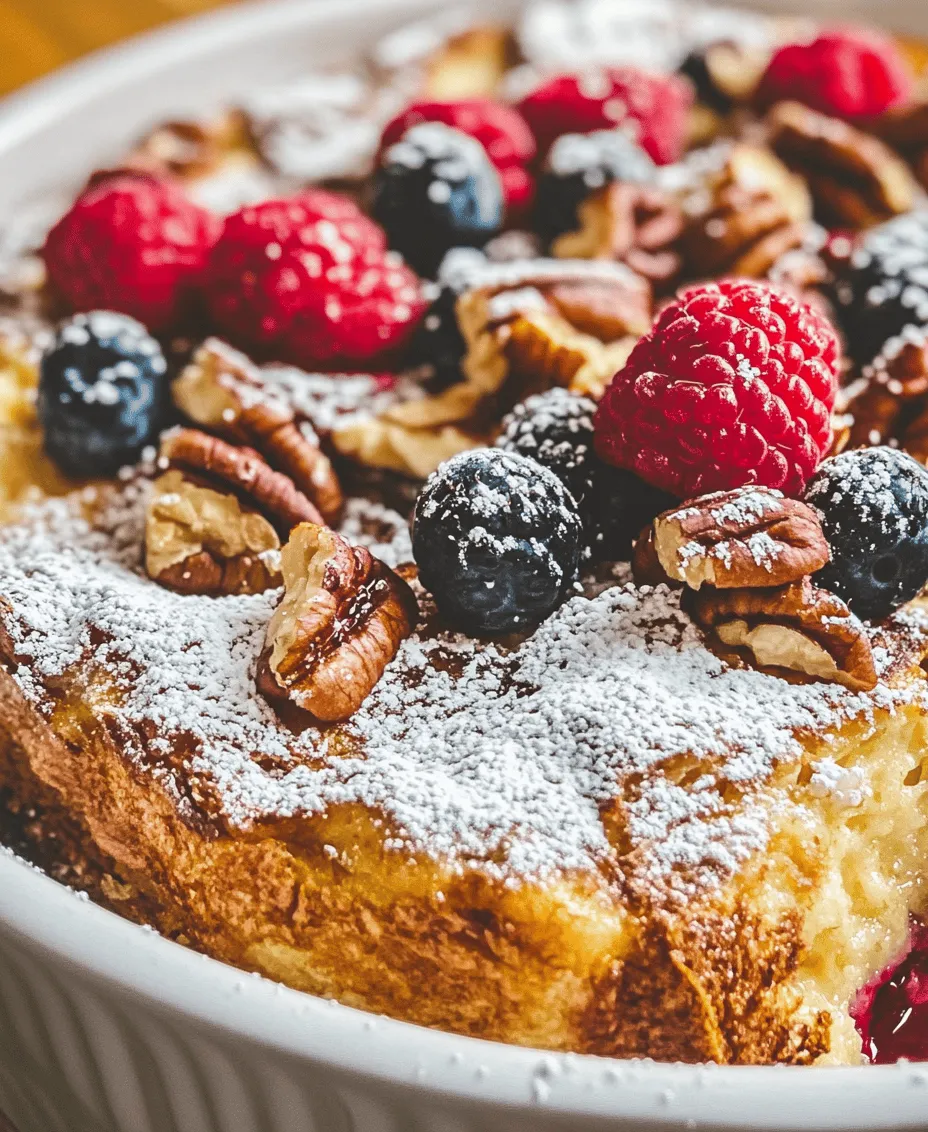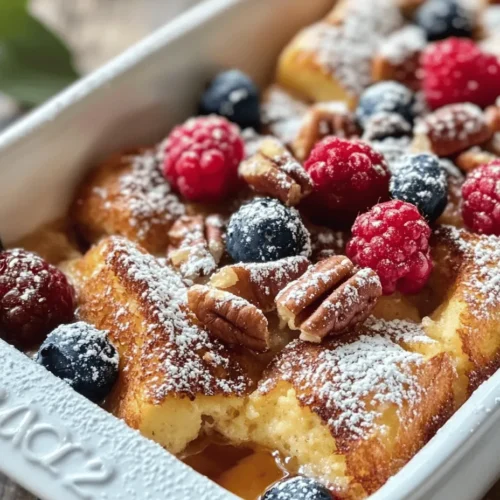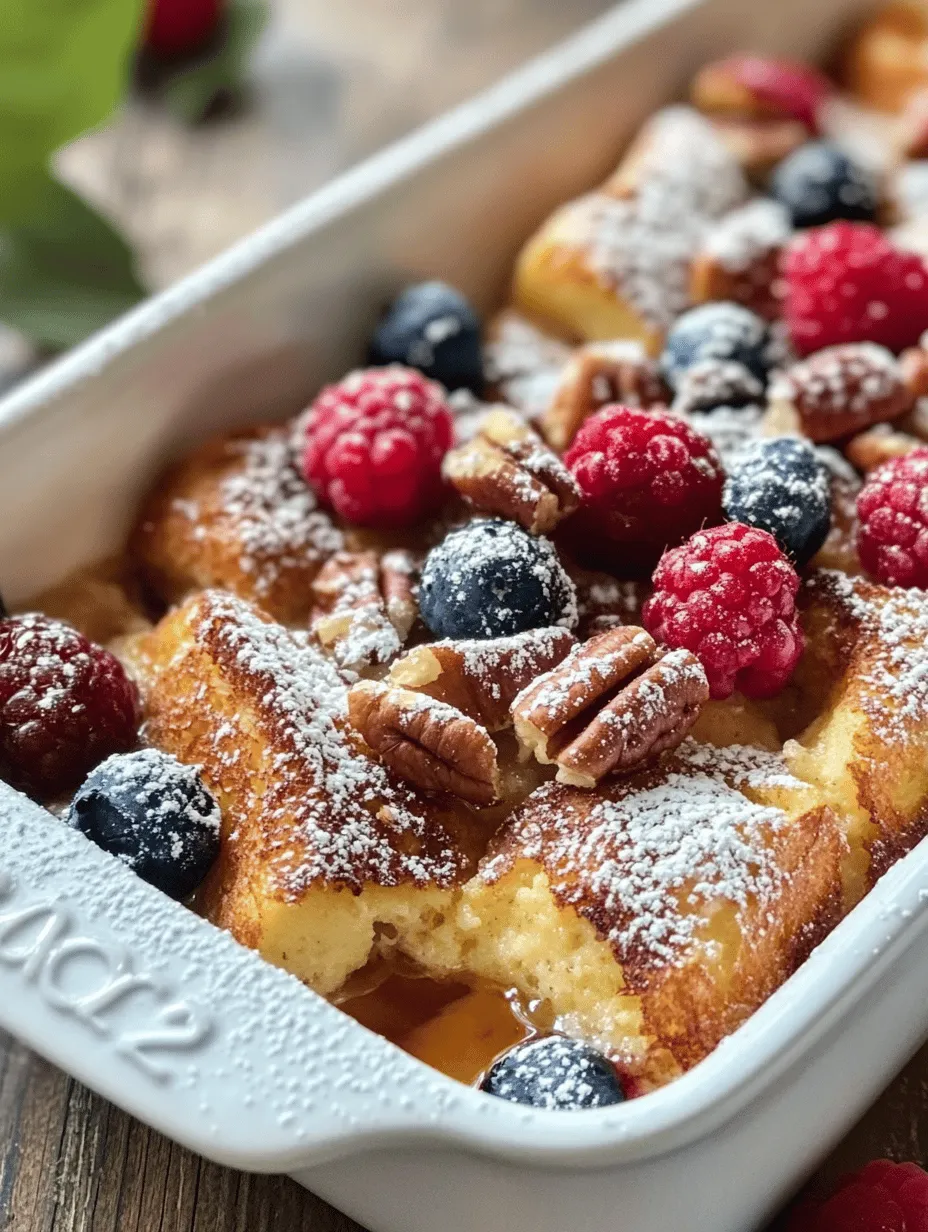If you’re looking for a scrumptious breakfast or brunch dish that impresses with minimal effort, the Overnight French Toast Casserole is your answer. This delectable dish combines the rich, comforting flavors of traditional French toast with the convenience of a casserole. Imagine waking up to the enticing aroma of cinnamon and vanilla wafting through your home, all thanks to a simple dish you prepared the night before. This casserole not only simplifies your morning routine but also makes it the perfect choice for family gatherings and special occasions—where delicious food and quality time go hand in hand.
The Allure of French Toast Casserole
French toast has a rich history that dates back centuries, with variations found in cultures worldwide. The concept of soaking bread in a mixture of eggs and milk has roots in ancient times, where it was a way to repurpose stale bread, minimizing waste. Over the years, it has evolved into a beloved breakfast staple, often garnished with fruits, syrup, or powdered sugar. Today, casseroles have become increasingly popular in modern cooking, allowing for a communal dining experience where everyone can enjoy a hearty meal together.
The Overnight French Toast Casserole encapsulates all that we love about traditional French toast while offering the ease of preparation that fits perfectly into our busy lives. This dish is a statement of comfort and indulgence, making it a favorite for many. Whether you are hosting a festive brunch, celebrating a holiday, or simply treating your family on a Sunday morning, this casserole is a timeless choice that brings people to the table.
Key Ingredients for Success
The success of any French toast casserole lies in its quality ingredients, and that starts with the bread. Day-old brioche or challah bread is ideal for this recipe. These types of bread are rich in flavor and have a slightly sweet taste, which enhances the overall dish. Their dense, soft crumb allows them to soak up the custard mixture beautifully without falling apart. Fresh bread can become too soggy, while day-old bread retains the perfect texture to create a delightful base for your casserole.
The Custard Mixture
The custard mixture is the heart of the Overnight French Toast Casserole, composed of eggs, milk, heavy cream, and sugar. Each ingredient plays a crucial role in achieving the perfect consistency and flavor.
– Eggs: They provide structure and richness, binding everything together while contributing to the dish’s creamy texture.
– Milk and Heavy Cream: Combining these two creates a luscious base that adds richness and enhances flavor. You can substitute dairy with almond or oat milk for a dairy-free version, which still delivers a fantastic taste and texture.
– Sugar: This ingredient balances the flavors and adds just the right amount of sweetness. You can experiment with brown sugar for a deeper caramel note or maple syrup for a unique twist.
Enhancing Flavor with Spices
To elevate the flavor profile of your casserole, spices like cinnamon, nutmeg, and vanilla extract are essential.
– Cinnamon: A classic addition to French toast, cinnamon brings warmth and aromatic qualities that perfectly complement the sweetness of the dish.
– Nutmeg: Just a hint of nutmeg adds depth and complexity to the flavor, making every bite irresistible.
– Vanilla Extract: This ingredient infuses the custard with a delightful fragrance and enhances the overall taste, making it feel more indulgent.
Optional Ingredients
To further boost the flavor and texture, consider adding nuts and fresh berries.
– Nuts: Chopped pecans or walnuts can provide a delightful crunch, contrasting beautifully with the soft bread and creamy custard.
– Fresh Berries: Adding strawberries, blueberries, or raspberries not only brightens up the dish visually but also infuses it with fresh flavors and a hint of acidity that balances the richness of the casserole.
Step-by-Step Preparation Guide
Preparing the Bread
The first step in creating your Overnight French Toast Casserole is preparing the bread. Cut the day-old brioche or challah into cubes, aiming for approximately one-inch pieces. This size allows the bread to soak up the custard evenly while maintaining enough structure during baking.
Tips for Cutting Bread:
– Use a serrated knife for clean cuts without squashing the bread.
– If the bread is too soft, consider placing it in the freezer for about 15-20 minutes before cutting. This will make it easier to handle.
Making the Custard
Next, prepare the custard mixture. In a large mixing bowl, whisk together the eggs, milk, heavy cream, sugar, and spices until smooth and well combined.
Importance of Whisking:
– Whisking not only combines the ingredients but also introduces air, which helps create a light and fluffy texture in the final casserole. Be sure to whisk until the sugar is fully dissolved, and the mixture is homogenous.
Dairy-Free Alternatives:
– If you prefer a dairy-free custard, substitute the milk and heavy cream with almond milk or coconut cream. These alternatives will still provide a creamy base while catering to dietary restrictions.
Combining Ingredients
With your bread cubed and custard mixture ready, it’s time to combine the two. In a large mixing bowl, gently toss the bread cubes with the custard mixture, ensuring each piece is evenly coated.
Techniques for Even Distribution:
– Use a spatula or your hands to gently fold the bread into the custard, being careful not to crush the bread cubes. This gentle mixing ensures that the custard seeps into every nook and cranny of the bread without losing its structure.
Importance of Gentle Mixing:
– Overmixing can lead to a mushy casserole, so take your time to ensure each piece of bread is coated without breaking them apart.
In the next part of this article, we will explore the final steps in preparing your Overnight French Toast Casserole, including how to allow it to soak overnight and the baking instructions for achieving the perfect golden-brown top. Stay tuned for tips on serving and storing your delicious creation!

Chilling the Casserole
Once your Overnight French Toast Casserole is assembled, it’s time to let it chill in the refrigerator. This step is crucial, as it allows the bread to soak in the egg mixture thoroughly, ensuring that each piece absorbs the flavors and moisture. The science behind soaking bread overnight is simple yet effective: as the bread sits, it becomes saturated with the rich custard mixture, which includes eggs, milk, sugar, and spices. This process not only enhances the flavor but also contributes to a perfectly custardy texture that contrasts beautifully with any crispy topping you might choose.
By allowing the casserole to chill overnight, you also give the flavors time to meld. Spices like cinnamon and nutmeg become more pronounced, creating a delightful depth of flavor that elevates the dish from simply good to unforgettable. Additionally, this overnight soaking makes for easier preparation in the morning, as you can simply place it in the oven upon waking.
Baking the Casserole
When you’re ready to bake your Overnight French Toast Casserole, preheat your oven to 350°F (175°C). It’s important to make sure your oven is fully preheated to ensure even cooking. Take the casserole out of the refrigerator and let it sit at room temperature for about 15 to 30 minutes before placing it in the oven. This helps to avoid shock to the dish, which can lead to uneven cooking.
As the casserole bakes, you’ll notice an enticing aroma wafting through your kitchen—an inviting scent that will surely draw everyone’s attention. Bake the casserole for about 40 to 50 minutes. To check for doneness, insert a knife or toothpick into the center; it should come out clean or with just a few moist crumbs attached. The top should be golden brown and slightly crisp, indicating that the casserole is ready to be enjoyed.
Visual cues are also essential during this phase. Look for a puffed appearance and a golden crust on top. If you notice that the top is browning too quickly, you can cover it loosely with aluminum foil to prevent burning while allowing the center to cook through.
Serving Suggestions
The beauty of the Overnight French Toast Casserole lies not only in its flavor but also in its versatility in presentation and accompaniment. When serving this delectable dish, consider dusting it with powdered sugar for an elegant touch. A drizzle of maple syrup adds a classic sweetness, elevating the dish further. Fresh berries, like strawberries, blueberries, or raspberries, can provide a refreshing contrast and a burst of color, making your presentation visually appealing.
For those looking to complement the casserole with sides, consider serving breakfast sausage, bacon, or even a light fruit salad. These options add texture and balance to your meal, making it hearty yet refreshing. If you’re hosting a brunch, consider arranging everything on a large platter, serving the casserole in squares or slices, and placing the toppings in small bowls for guests to customize their plates.
Nutritional Information
When it comes to indulgent dishes like Overnight French Toast Casserole, it’s helpful to have an understanding of the nutritional content. On average, a serving of this casserole contains approximately 300-400 calories, depending on the specific ingredients used. Key nutrients typically include carbohydrates, protein from the eggs and milk, and, of course, a delightful dose of sugar.
While it is a treat, there are ways to enjoy this dish while maintaining a balance in nutrition. Consider using whole grain bread for added fiber or substituting some of the sugar with a natural sweetener like honey or maple syrup. For a lighter version, you can replace whole milk with almond milk or use egg whites instead of whole eggs. These substitutions will allow you to enjoy the classic flavors without sacrificing your dietary goals.
Variations and Customizations
The Overnight French Toast Casserole is a canvas for creativity, allowing you to explore various flavor profiles and dietary adaptations. For a chocolate lover’s delight, consider adding chocolate chips to the custard mixture before baking. Alternatively, you could infuse the dish with seasonal fruits, such as diced apples or chopped peaches, for a fruity twist.
For those needing dietary accommodations, gluten-free bread can be used as a substitute, ensuring that everyone can enjoy this delicious dish. Vegan adaptations are also possible; simply substitute eggs with a mixture of flaxseed meal and water or silken tofu, and replace dairy milk with a non-dairy alternative.
Additionally, consider enhancing the textural experience by adding nuts such as pecans or walnuts on top before baking. This not only adds crunch but also introduces healthy fats, making the dish more satisfying.
The Perfect Occasions for Overnight French Toast Casserole
Overnight French Toast Casserole is the quintessential dish for numerous occasions. Whether it’s a holiday gathering, a weekend brunch, or a family reunion, this dish shines in both its presentation and flavor. Its ability to serve a crowd effortlessly makes it a go-to option for hosts.
Imagine a cozy Christmas morning where family members gather around the table, the aroma of baked French toast filling the air, or a sunny Sunday brunch with friends where each person can indulge in this delightful dish. Anecdotes from readers reveal how this casserole has become a beloved tradition in many households, often associated with warm memories and laughter shared over a meal.
Conclusion
In summary, Overnight French Toast Casserole is not just a recipe; it’s a celebration of flavors, convenience, and community. With its simple preparation and the ability to serve multiple guests, it stands out as a go-to dish for both novice cooks and seasoned chefs alike. The combination of soaking, baking, and serving allows for a delightful culinary experience that encourages creativity and personalization.
As you embark on your own journey with this recipe, remember that it’s not just about the food; it’s about the memories you’ll create around the table. So gather your ingredients, prepare your casserole, and enjoy the delicious moments that follow. This dish is sure to become a staple in your cooking repertoire, inviting warmth and joy into every meal.



